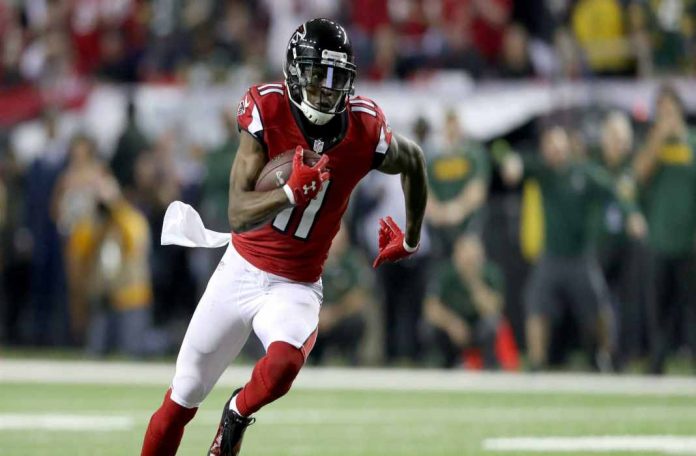Julio Jones and touchdowns. Name a more platonic relationship.
At least, that’s what the media and NFL community will have you believe. Does the Alabama product deserve the blame?
This should go without saying, but it’s something that a lot of fans seem to forget: outside of the occasional tipped pass, 99% of a receiver’s production comes from being targeted. Putting completion percentages aside, if a quarterback isn’t throwing to his receiver, said receiver isn’t going to produce.
For Jones, that’s been the (unfortunate) story of his career.
According to profootballreference.com, Jones did most of his damage this past season when the Falcons’ offense was on their own 21-50; hauling in 51 of his 81 targets in that zone for 835 yards. Once the Falcons crossed into opponent territory, Jones’ targets dipped.
When the Falcons were anywhere between the opponents’ 49-20, Jones was targeted 54 times, pulling in 40 targets for 593 yards.
In the red zone, Jones was only targeted 17 times (10 receptions for 100 yards and five TDs).
When the Falcons were between the opponents’ 1-10 yard line, Jones (and his 6’3″ frame) was only targeted seven times, which he “turned” into three receptions for three(!) yards and two TDs.
Now, all of those numbers could be attributed more to Steve Sarkisian’s ineptitude to run an NFL offense over the past two seasons. However, this has been a trend for his entire career… literally.
- In 2017, Jones was targeted in the red zone only 18 times. He totaled a mere five receptions for 33 yards and one TD. When the Falcons were between the opponents’ 1-10 yard line, Jones was only targeted 11 times, (four receptions for 16 yards and one touchdown).
- The year prior (2016), Jones was targeted in the red zone nine times. He was credited for four receptions for 22 yards and two touchdowns. When the Falcons were between the opponents’ 1-10 yard line, Jones was only targeted six times (three receptions for 11 yards and two touchdowns).
- 2015 seems to be the anomaly (when current San Francisco 49ers head coach Kyle Shanahan was offensive coordinator) for Jones. Shanahan utilized Jones effectively, helping Jones turn his 21 red zone targets and 12 targets between the opponents’ 1-10 yard line into 12 receptions for 83 yards and five touchdowns and six receptions for 29 yards and four touchdowns, respectively.
- In 2014, Jones was targeted in the red zone 11 times. He saw seven receptions for 59 yards and two touchdowns. When the Falcons were between the opponents’ 1-10 yard line, Jones was only targeted five times. He caught two passes for 16 yards and one touchdown.
- In 2013, Jones was targeted in the red zone nine times. He caught five passes for 17 yards and one touchdown. When the Falcons were between the opponents’ 1-10 yard line, Jones was only targeted seven times. He brought in four of those targets for 12 yards and one touchdown.
- 2012 was a solid year for Jones. He was targeted in the red zone 20 times (second-highest total of his career). As a result, he caught 11 passes for 108 yards and seven touchdowns. When the Falcons were between the opponents’ 1-10 yard line, Jones was targeted 10 times which he converted into three receptions for 20 yards and three touchdowns.
- In 2011 (his rookie season), Jones was targeted just eight times in the red zone, when he caught four passes for 48 yards and two touchdowns. When the Falcons were between the opponents’ 1-10 yard line, Jones was only targeted one (!) time, never catching a pass or touchdown.
Some will look at these numbers and continue the narrative that Julio Jones isn’t an elite receiver. Others will attribute it to the overturn at the offensive coordinator position the Falcons have undergone. Others still will put the blame more on Matt Ryan.
All of these arguments have merit.
Julio Jones has never led the league in touchdowns and has only led the league in receiving twice – 2018 and 2015. (Jones has also only finished top-five in receiving yards three times).
He’s had four different offensive coordinators since entering the league.
Outside of two games of Chris Redman in 2009, Matt Ryan has been the only quarterback Jones has ever had. Coaching staff and receiving corps changes aside, Ryan and Jones have been together for eight seasons, combining for 49 touchdowns. To put that in perspective, Ryan threw 10 touchdown passes this past season to Calvin
Now, on the flip side, (as already mentioned) Jones has led the league in receiving twice and finished second in consecutive seasons (2016-17 regular seasons). Those are no easy feats. He’s not the one calling the plays.
But where do you draw the line?
Where does the blame end and talent run out?
@_Mason_Jar

